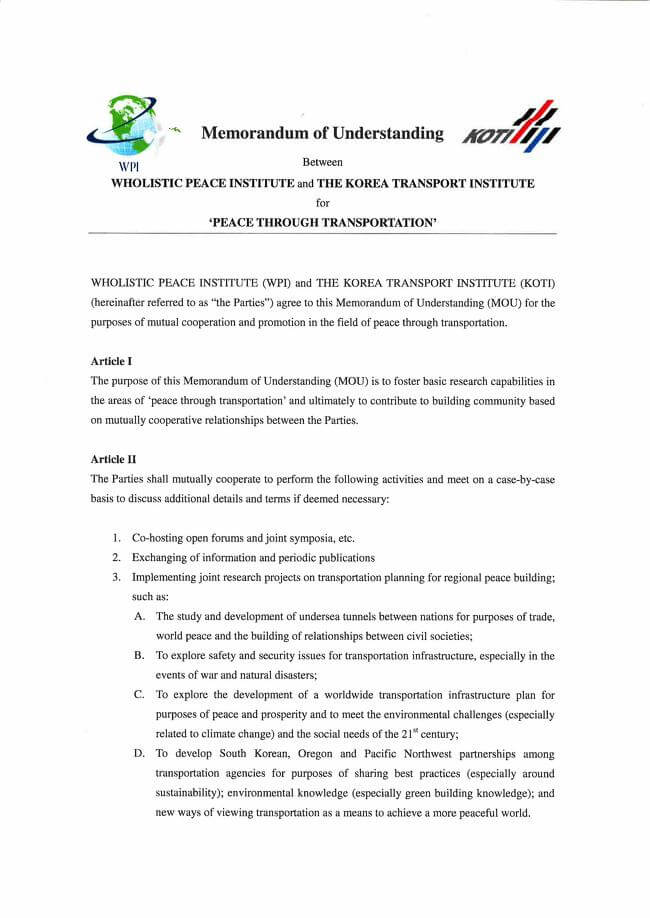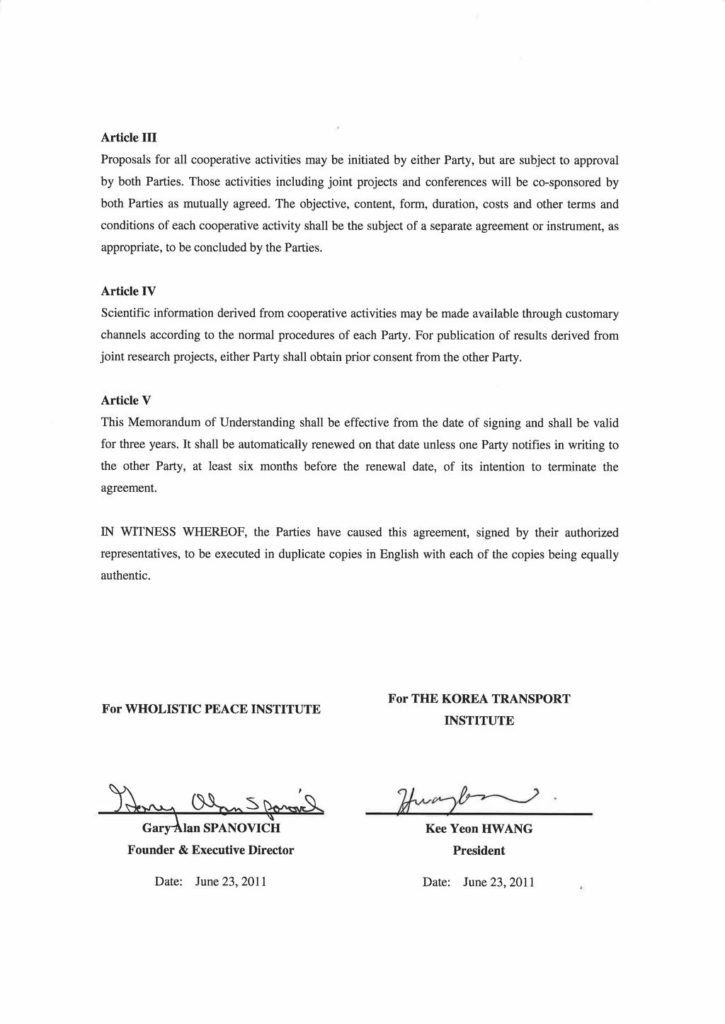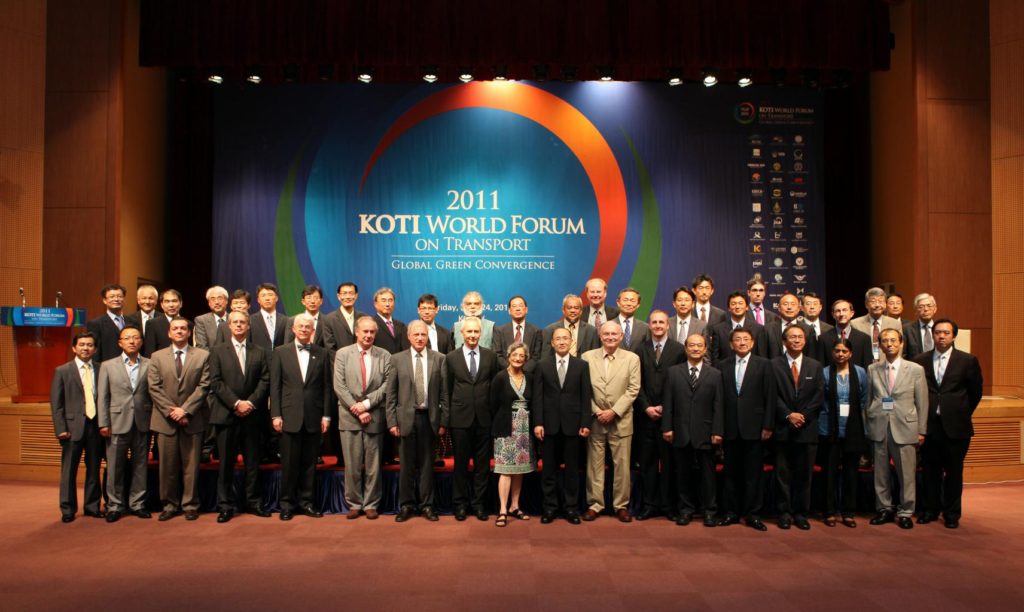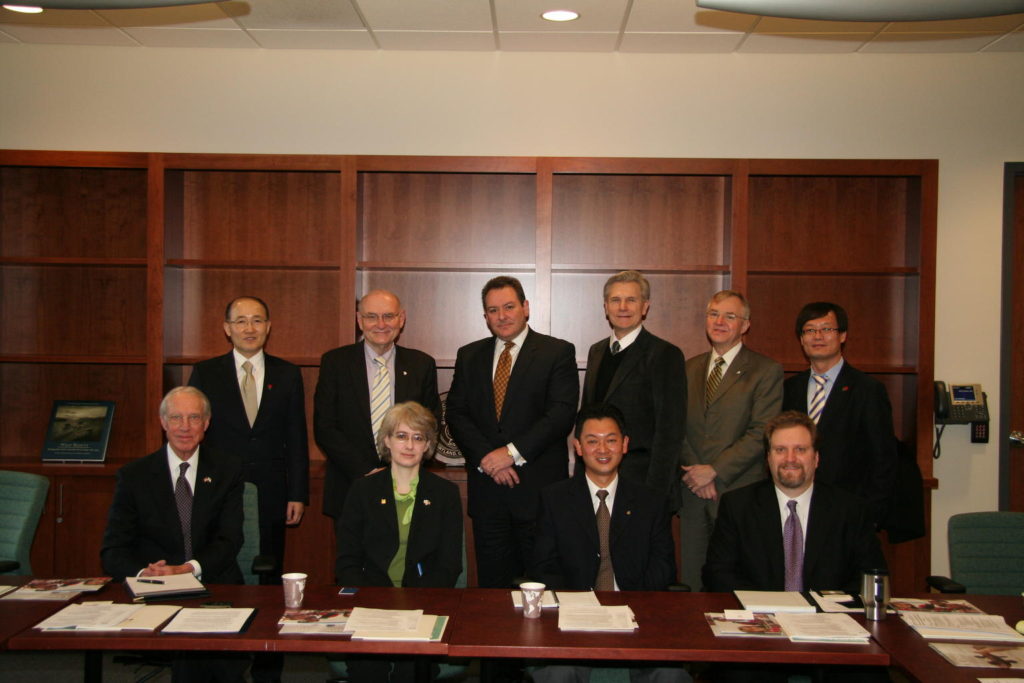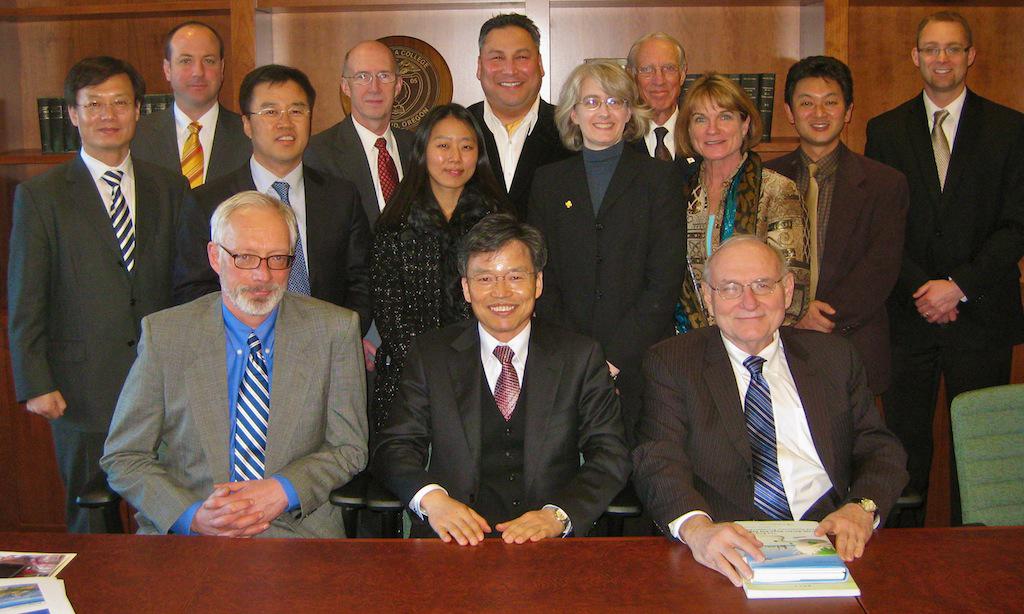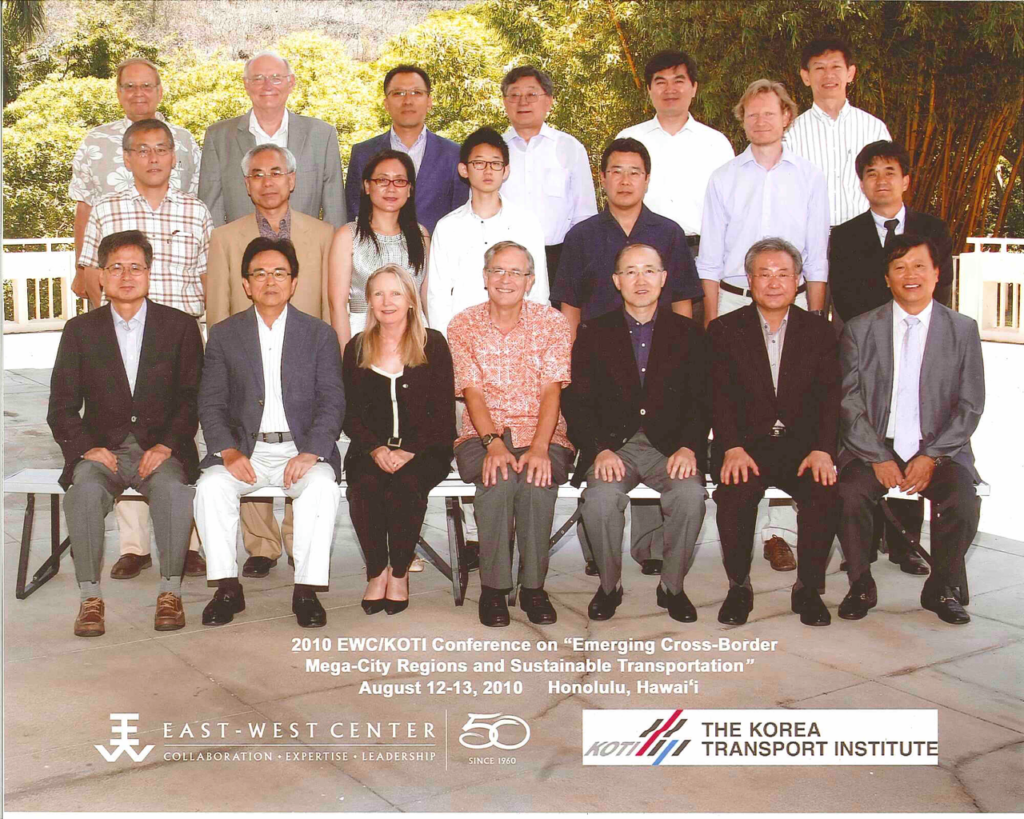Gary Spanovich speaking at the Korea Transport Insitute (KOTI) 25 year anniversary in 2011 in Seoul, South Korea on “Peace and Transportaion.” Gary’s talk was on the developing mega cities in the world. These cross border emerging huge cities will have an effect on world peace and security issues, this is no where more obvious than Asia, China, South korea and Japan. These major courters of emegrging cities and transportatin needs will eventually create the need for undersea tunnels between the united state and Russia throgh the barring straight. Thorough China and the Korean Peninsula and between Japan and the Korean Peninsula. During this time Gary was appointed by a group of Chinese, Korean and Japanese government officials and professors President of the newly formed World Undersea Tunnel Association.
Monday, January 31, 2011; 9am to Noon
Transportation Trade and Research Partnerships
The Korea Transport Institute (KOTI); Seoul, South Korea &
Oregon Firms and Agencies
Keynote Speaker: Dr. Keith Hwang, President of the Korean Office of Transportation (KOTI). Also Dr. Ye, Choong Yeol of KOTI, currently seconded to the World Bank will also participate.
Conference Sponsors: Organized by the Wholistic Peace Institute (WPI) and its Transportation Research and Futures Program; Co Sponsors: Concordia University; Kittelson & Associates
Speakers: Neil McFarlane, Executive Director, Tri-Met; Matthew Garrett, Executive Director, Oregon Department of Transportation; Susie Lahsene, Transportation Director, Port of Portland; Others
Location: George R. White Library & Learning Center; Concordia University
Agenda for Day:
- 8-9am: Registration
- 9am: Opening Remarks Gary Alan Spanovich; Introduction of Speakers; World Undersea Tunnel Association; Development in China; John Bates-Oregon Korean Consul General; Gary Withers, Concordia University, Executive Vice President
- 9:10am: Dr. Kee Yeon (Keith) Hwang; President of the Korean Office of Transportation (KOTI): Work of KOTI; Research partnerships with KOTI; Business and trade opportunities with KOTI and South Korea; Q & A
- 10:00am: Matthew Garrett; Neil McFarlane ; Susie Lahsene; Andy Cotugno
- 11:00am: Question and Answer; Gary Spanovich, moderator
- Noon to 1:30: Hosted Lunch by Concordia University For Invited Speakers & Dignitaries
- Afternoon: Individual meetings; 1:30-3:30 for those interested
- Kittelson & Associates Hosted Dinner for Invited Guests
Forum on Peace through Transportation; Friday, January 27, 2012; Second Annual Forum
A Joint Project of the WPI (Wholistic Peace Institute) and KOTI (Korea Transport Institute)
Hosted By The Concordia University
“We are in the midst of a period of rapid climate change and natural disasters; additionally, global financial crises and competition for limited natural resources are placing challenges on our nation’s economy (South Korea). In response, our government has stated that “humanism and creativity” and “a fair and just society” are its top priorities for governance. Within this national and international context, one requires an active role in research and development of national policies along with a paradigm shift in the transport sector”. President Gyeng Chul Kim, of The Korea Transport Institute (KOTI)
January 27th Schedule
8:30am to 8:50 am: Registration; Tea & Coffee & Light Snacks Available
8:50am: Introductions; Gary Spanovich-WPI; Mark Wahlers-Provost, Concordia University
South Korean Transportation Officials Coming To Portland:
- Dr. Gyeng Chul Kim, President of KOTI
- Dr. Young-Jun Moon, Director; Center for ITS and Olympic Transport, KOTI
- Dr. Choongyeol Peter Ye, Port Container Rapid Transit System Expert. KOTI
- Dr. Ok Namkung, Public Relations Officer of KOTI
9:00am: (60 minutes) Dr. Kim, Gyeng Chul, President, KOTI (The Korea Transport Institute)
- Dr. Gyeng Chul Kim will discuss “Sustainable Transportation Systems in Korea” with focus on Nation’s economic and infrastructure development for the past 60 years in support of US government, and; Korea’s public transportation systems reform in 2000s such as Bus Rapid Transit project (BRT) in 2004 and Cheonggye Stream Restoration project from 2003 to 2005. (20 minutes)
- Screening a video clip on Korea’s development history (10 minutes)
- Dr. Young Jun Moon will discuss Korea’s sustainable transport system in future-oriented perspective dealing with transport issues such as intelligent smart cards-one card pays for all; car sharing (cloud transport system, CTS); integration and sustainability issues; ITS-cooperative system; new transit ideas; bike rapid transit facilities; and other alternative ideas. He is also the chair of the Transportation Division in Pyeong Chang 2018 Olympics (15 minutes); Followed by Q & A (15 minutes)
10:00am: (15 minutes) Professor Gary Alan Spanovich, Executive Director, WPI (Wholistic Peace Institute); Adjunct Professor, Concordia University
- The WPI/KOTI MOU on Joint Projects Related to Climate Change, the developing Asia Mega-City Phenomenon, Nation to Nation Undersea Tunnels, and its relations to World Peace
10:15am: 15 Minute Break
10:30am: (30 minutes) The Korean Transportation Money Card & the Tri-Met Transit Card: The Korean prepaid card (called the “money card” in South Korea) with electronic sensors (does not have to be removed from the wallet) which can pay for: Highway tolls; parking fees; train fares; bus fares; light rail fares; subway fares; movies; some registration and licensing fees. The One Card Pays for All Transportation Fees was launched in South Korea 5 years ago and is like an electronic “point of sale” system which functions in real time.
- Conversation between Neil McFarlane, General Manager of Tri-Met and the implementation of a transit card and Dr. Kim, Gyeng-chul, President of KOTI and Dr. Moon on the “Korean Money Card”; and audience participation.
11:00am: (30 minutes) The KOTI Proposed Container Rapid Transit System: Exploration of the proposed Korean Rapid Transit Container System; an innovative idea that would build a container moving infrastructure system for containers to go directly from ships in Korean Ports to a conveyor built to Seoul initially and then other Korean cities, thus eliminating long haul trucking and rail transport. This would greatly increase the efficiencies of moving freight in Korea between production (factories) and distribution points (ports) and other points.
- Conversation between Susie Lahsene, Transportation Policy Director, Port of Portland and Dr. Choongyeol Peter Ye, Port Container Rapid Transit System Expert. KOTI, audience involvement
11:30am: (30 minutes) Keeping Transportation Infrastructure Safe in Korea and in Oregon
- Conversation between Professor Scott Winegar, Concordia University Security Studies Director and four KOTI officials
12:00pm: Hosted Lunch; Marcus Nobel, Senior Member of the Swedish Nobel Family Will Be Our Lunch Speaker and will discuss his United Earth NGO and his upcoming trip to Rio + 20 (see unitedearth.us)
- American cities have been built around the automobile. Almost everything that we do in our daily lives requires us to get in our cars and drive somewhere. The simple act of walking, riding a bike or taking mass transit is a great alternative, but sometimes not realistic. City planners and transportation designers have a profound affect on the quality of our lives by how they organize our Transporation priorities. By building urban centers that get people out of their cars we will become more healthy society and allow for a healthier natural environment.
1:00pm: Discussion on a 2012 Sharing of Best Practices Exchange of Officials; Seoul and Portland. The trip will build new relationships between Oregon and South Korea and share practices on sustainability; environmental issues; infrastructure security issues; and also discuss how transportation has been a world peace approach, in the past and could be now
- The WPI and KOTI are proposing that Oregon transportation agencies, firms, Universities involved in transportation issues visit Seoul for a one week in 2012 to form partnerships and relationships; KOTI will set up the meetings and the schedules
- The WPI and KOTI are proposing that Korean transportation agencies, firms, Universities involved in transportation issues visit Portland for a one week in 2012 to form partnerships and relationships; the WPI and Oregon agencies will set up the meetings and schedules
1:30: Forum Ends
RESUMES OF SOUTH KOREAN GUESTS FOLLOW
Gyeng Chul KIM Ph.D, P.Eng.
President of KOTI
Dr. Gyeng Chul Kim is the President of the Korea Transport Institute (KOTI). He received his PhD in Transport Planning and Administration at Seoul National University in 1993. Upon completing his PhD, he taught graduate research courses at University of Leeds in UK and Kyoto University in Japan.
His career in transport policies and management spans nearly two decades with engagement in both the public and private sectors with specific interests in public transport, such as subways and buses. He serves as a member of the Transport Committee of Seoul Metropolitan Government as well as the Committee for Rail Division of the Board of Audit and Inspection. Additionally, Kim currently heads the public transport committee of Korea Transportation Research Society.
Dr. Kim is currently on leave from KAIST, where he teaches green transport policy in the Graduate School of Green Transport, to serve as president of KOTI. Prior to joining KAIST, he served as the CEO of Veolia Transport Korea, which operates Seoul subway line 9, from 2009 to early 2011.
Dr. Gyeng Chul Kim is also a former Director of the Department of Urban Transit in Seoul Development Institute (SDI). While at SDI, he conducted the Seoul Bus System Renovation Project titled “Seoul’s Challenges for Reducing Congestion and Increasing Public Transportation Ridership to Improve Sustainability.” This project demonstrated how a large and rapidly-growing city like Seoul could increase ridership and relieve congestion in the shortest period of time by constructing public transport infrastructure. This project presented some of the latest measures implemented to relieve gridlock including the following: (1) Construction of median exclusive bus lanes (BRT) and reorganization of the bus network, (2) Reform of the institutional framework including contracting private-public co-operating systems, and (3) Integration of multimodal electronic fare (SMART card) systems and transport operation and information systems, etc.
PROFESSIONAL AFFILIATIONS
CITYNET – Deputy Secretary General 2008 – present
Regional Network of Local Authorities for the Management of Human Settlements
Korea Urban Rail Association – Senior Executive Director 2009 – present
UNCRD for Environmentally Sustainable Transport (EST) – Expert Supporter 2006 – present
MOCT Board of Audit and Inspection, Rail Sector – Committee Member 1999 – present
Downtown People Mover Project – Committee Member 1999 – present
Seoul Metropolitan Government SOC – Committee Member 1998 – present
Railways in New Airport for Seoul – Committee Member 1998 – present
Project manager of private capitalization for Seoul Urban Rail 1997 – present
Consultant for Korean Urban Rail Technology Unit 1997 – present
Green Network of Korea – Director Volunteer 1992 – present
Toward Better Public Transport: Experiences and Achievements of Seoul. SDI, 2005.
Reform of Seoul transit System: One-year outcomes and Experience, the 4th UITP World Congress, 2004.
Design & Implementation of Bus Rapid Transit, SDI, Seoul, (In Korean) 2004.
Future Bus System: BRT, SDI, Seoul, 2003.
Urban Railways, Nohe Publisher, 2001.
Planning and Design of Transit Mall, SDI, Seoul, 1999.
Guideline for Construction of Sustainable City, SDI, Seoul, 1999.
Planning and Construction of Urban Rail in Overseas, SDI, Seoul, 1998.
A study on encouraging urban rail use by improving facility, SDI, Seoul, 1998.
A Development of Traffic Assignment: Reflecting Effect of Signalized Intersection, The 4th ITS World Congress, 1997.
A Study on applicability of ITS for Seoul, SDI, Seoul, 1994.
Dr. Young Jun Moon,
Director; Center for ITS and Olympic Transport, the Korea Transport Institute
Dr. Moon is Director; Center for ITS and Olympic Transport, the Korea Transport Institute and joined the Korea Transport Institute (KOTI) in 1998, right after he had graduated in the Univ. of Illinois at Urbana-Champaign (UIUC) with a doctoral degree of Transportation Engineering in the Dept. of Civil and Environmental Engineering. He started his career as a research engineer in the Agency for Defense Development (ADD) in 1987, developing Korean Surface to Air Missile (KSAM) for the military weapon systems.
He participated in ITS World Congress and the International Standard Organizations in ITS area as a leader of ITS R&D in Korea from 1999 for developing a variety of ITS projects including the wireless interface signal control systems project utilizing DSRC. Since then, he has been involved in ISO/TC204 as not only an expert in WG14 vehicle/roadway warning and control system but also Convener of WG17 nomadic & portable devices for ITS service. He is also a member of National Science and Technology Council under the President House, and a chair of Transportation Division in Pyeong Chang 2018 Olympic and Paralympics Winter Games Bid Committee since 2010.
Choong Yeol (Peter) Ye, The World Bank, Senior Transport Specialist
Choong Yeol(Peter) Ye joined the World Bank in June 2010 as a secondee from the Korea Transport Institute(KOTI). He was former Director of Planning and Administration at KOTI. He has served as Director of Logistics and Air Transport Department for several years. He has more than 20 years experience in the field of transportation research. He has conducted various studies on transport and logistics at KOTI. His research interests include global logistics and transportation system; air cargo transportation and intermodal freight transport; air transportation; green logistics technology and policy. He also has worked at the Presidential Committee on Northeast Asian Business Hub as a secondee for two years and contributed in establishing Northeast Asian Logistics Hub Strategy of Korean government, Logistics Industry Nurturing Plan, and improving various regulations on logistics. He received Ph.D. degree in transportation engineering from Loughborough University in the UK. He holds a master’s degree in transport planning from Seoul National University and a bachelor’s degree in aviation management from Korea Aerospace University.
2010 EWC/KOTI International Conference on “Emerging Cross-Border Mega-City Region and Sustainable Transportation” Synopsis
Mega-cities have been described as the urban phenomenon of the 21st century. All nations in the world are now engaged in competing globally to strengthen their national competitiveness by promoting the global role of such cities and nurturing their extended ‘mega-city regions’ as integrated economic units. Extending far beyond a single core city and its surrounding suburbs, mega-city regions are seen as the engines of the global economy, efficiently connecting flows of goods, people, culture and knowledge in a multi-centre, or polycentric, urban formation.
Polycentric mega-city regions have indeed become one of the main spatial patterns of urban agglomeration and development in the world. The polycentric global ‘mega-city region’ is characterized by intense connectivities at multiple spatial scales in the ‘information’ or ‘network’ society, hence multi-level governance is required to deal with associated increasing urban competition in the global environment.
Since the mid-1980s, the mega-city region, a country in a country, has thus emerged as a unit of prosperity as population, economy, transportation infrastructure, and cultural facilities have been concentrated at this globalizing spatial scale. If we want to bolster national economic competitiveness and ensure future sustainable prosperity, we must pursue policies that take mega-cities and their polycentric regions into account.
Both developed and developing countries are producing policies to strengthen their global competitiveness, or to catch up with the leaders of the world economy which are undergoing changes in the wake of the global financial crisis. As global competition intensifies and the world economic structure shifts to high value-added, knowledge-based industry, nurturing and management of polycentric mega-city regions is becoming increasingly vital.
In advanced countries, the mega-city is playing a pivotal role in national socio-economic development strategy. U.S. President Barack Obama has adopted the “Metro Nation” policy as a new national project. Europe is trying to strengthen its global competitiveness, with France announcing a “Grand Paris” project and in the United Kingdom, Boris Johnson has recently published a draft replacement “London Plan.” In January 2010, the Tokyo Metropolitan Government formulated the 2010 Action Program for Tokyo’s urban strategy, “Tokyo’s Big Change: The 10-Year Plan,” which presents Tokyo’s vision of the global mega-city in the Olympic year of 2016 to compete against other global mega-cities, thereby enhancing its global economic competitiveness through state interventions. China is utilizing a strategy that tests the second-phase reform in 10 wider mega-city regions including the Pearl River Delta (PRD) under the jurisdiction of Guangdong Province, the Yangtze River Delta region covering Shanghai, Zhejiang and Jiangsu provinces, and the Jingjintang region comprising Beijing, Tianjin and Tangshan.
More recently, the transnational/cross-border metacity is being created as existing metropolitan regions in different countries are becoming increasingly functionally inter-linked, aided by developments in information and communication technology (ICT) and transportation. The Financial Times, in its 8 April 2010 article on “From megacity to metacity,” introduces the concept of metacity as a new breed of city. “North-western Europe has become a de facto metacity, and a successful one at that, thanks to its infrastructure.” Strategy to promote political co-operation within the EU aims to counter urban competition detrimental to Europe’s global competitiveness, underpinning metacity emergence.
The 2010 EWC/KOTI Conference is designed to provide a unique forum for two days of intensive dialogue on emerging global polycentric mega-city regions, the motors of an increasingly integrated world economy. The conference aims to address key debates about the future of cities in the global economy. It will engage with a number of key terms that have been associated with the dramatic urban development observed by academics and policymakers around the world in the first decade of the 21st century. The conference will also make a comparative analysis of the following five models of cross-border regionalization in Europe and East Asia.
First, as a new 21st century urban phenomenon, the networked polycentric mega-city region is emerging in North-western Europe. It is characterized by a cluster of eight metropolitan regions (the Randstad Netherlands, Central Belgium, South-East England, Greater Dublin, RhineRuhr and Rhine-Main Germany, Paris Region and Northern Switzerland), physically separate but intensively networked in a complex spatial division of labor. As a strategy for renewing its international competitive position vis a vis other world regions, the EU ‘Lisbon’ agenda has brought urban agglomeration policy to the fore with specific concern for the economic dynamism of such regions.’ The Conference intends to learn from the success stories and hard lessons from ‘metacity’ development in North-Western Europe.
Secondly, the Oresund regionalization is cross-border collaboration between Denmark and Sweden. In the early 1990s, Sweden faced the worst economic crisis. During the same period, Demark lost its international competitiveness because of the excessive welfare expenditures. As a result, the unemployment surpassed 10%. To create a new integrated economic unit, the governments of the two countries agreed on constructing the Oresund Bridge which links between Copenhagen of Denmark and Malmö of Sweden. When the Oresund Bridge was actually opened in 2001, Copenhagen and Malmö were transformed into a new internationally competitive European metropolis. In turn, this has opened up an era of opportunity for people and businesses in the Øresund region. As talented and productive people of Copenhagen and Malmo clustered and concentrated in the Oresund region, a new constellation of Copenhagen and Malmo has turned into a new magnet for attracting the multinational corporations and foreign direct investments on bio-technology, medicine, life science and IT from the rest of the world into the Oresund region. Because of this clustering force via the Oresund Bridge, the cross-border metropolis has turned into Medicon Valley, a new engine of economic growth. The unemployment rates were reduced to 4 percent in Copenhagen and 7 % in Malmo from 10-15% in the mid-1990s. Moreover, the economic growth rates surpassed by 1.5 times of the national average. The cross-border metropolis presented an attractive investment to the multinational companies. Furthermore, with the opening of the Øresund Bridge and the discontinuation of the ferry services in the southern part of Øresund, greenhouse gas emissions were significantly reduced.
Thirdly, cross-border regionalization and regional governance in the Greater Pearl River Delta which consists the PRD, Hong Kong and Macao Special Administrative Regions is unique under the framework of “one country, two systems.” Hong Kong is the original champion of the region state, now needs to move into broader cross-border collaboration. Hong Kong, which used to play a dragonhead role in the region as a major capital source and service provider, shows signs of decline in the context of new regional development and restructuring in the PRD region. As a result of intensive cross-border integration and inter-city competition, a polycentric mega-city region has been emerging in the PRD by linking Guangdong Province, Hong Kong Special Administrative Region, and Macao Special Administrative Region through constructing the Hong Kong-Zhuhai-Macau Bridge as a sustainable transportation. The regional governments attempt to form effective clusters to attract FDI by division labor: Hong Kong as financial centers, properties, shopping, and logistic hub for sea and air transportation; Macao as casino, entertainment, and international conference; Shenzhen/Guangdong as JIT manufacturing for electronics.
Fourthly, a new scenario for cross-border regional collaboration is emerging in Northeast Asia. The Pan Yellow Sea Region (PYSR) is a de facto economic community without a script, but regional interdependence is comparable to EU. PYSR includes Northern China’s Bohai Rim, Japan’s Kyushu area, and western and southern Korea. The Northeast Asian model of cross-border regional collaboration is without government leadership. China has been the catalyst to cross-border trade and FDI, providing a stage for everyone to become global in East Asia. As China dominates, Japan goes upstream, and Korea downstream, trying to seek their favorite/profitable roles. PYSR has launched some directional “branding”, though perhaps unintentionally. With China’s regional autonomy and development, Busan concentrates on hub and spokes for the Pan Yellow Sea Free Trade Zone, while Japan specializes on supplier of machinery and critical components.
Finally, the cross-border semi-peripheral cooperation between Busan and Fukuoka is emerging as a new regionalism. The two port cities share similarities in geo-economic conditions. Busan is situated in weakening economic position against the Seoul metropolitan region and Fukuoka is isolated from the Kanto, Chubu and Kansai mega-city regions. While the distance between the two cities is 208 kilometers, Busan is 428 kilometers away from Seoul. To cope with relatively weaker international competitiveness in a global economy, the mayors of the two cities agreed to combine the economic synergy of the southeastern Korean Peninsula and Kyushu Island of Japan into an integrated economic unit and create a common economic zone, thereby raising the competitiveness of both cities in the global economy. In considering that the new LCC-focused airport is scheduled to be built in southeastern Korea and that China will become the largest tourist market in the world, the climatic and geographical advantages of the Korea-Japan strait zone could provide very favorable initial conditions for developing a new industry of medical tourism services. The Busan-Fukuoka medical tourism hub could also target the growing class of affluent, elderly Japanese.
In each model of cross-border regional collaborations, the Conference will focus on how businesses and politics interrelate and interact in geographical space. The Conference will also address the functional connectivity, the global competitiveness, the regional cross-border cooperation and the efficient transportation network of the emerging five mega-city regions. The polycentric mega-city regions, if they are to function as integrated economic units, require better, more effective, and faster ways to move goods, people, and ideas. Accordingly, the thrust of the 2010 EWC/KOTI Conference is to evaluate “sustainable transportation” development as an effective way to achieve the economic growth of emerging cross-border mega-city regions in Europe and East Asia.

